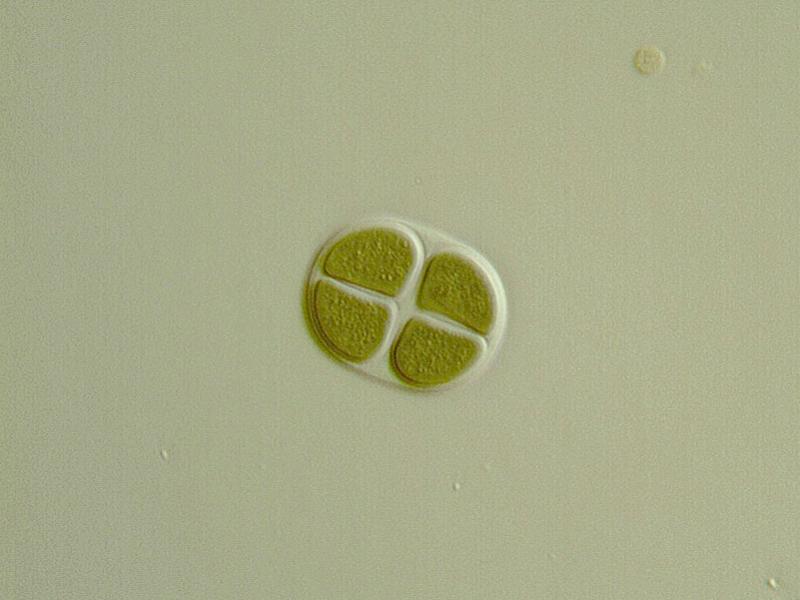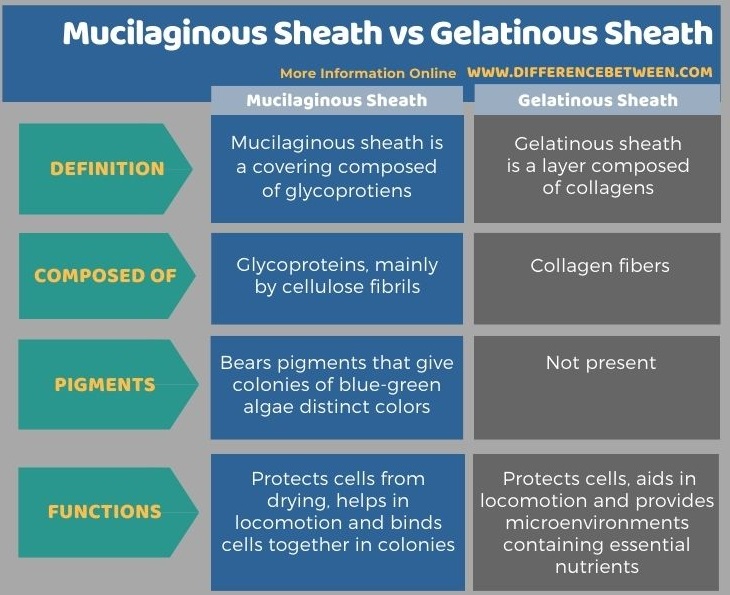Difference Between Mucilaginous Sheath and Gelatinous Sheath
The key difference between mucilaginous sheath and gelatinous sheath is that mucilaginous sheath consists of glycoproteins while gelatinous sheath consists of collagens.
Cyanobacteria are photosynthetic bacteria. They are also known as blue-green algae. They are unicellular prokaryotic organisms. There are two types of sheaths around the cyanobacterial cells: mucilaginous sheath and gelatinous sheath. The mucilaginous sheath consists of many cellulose fibrils arranged reticulately in the homogenous matrix. Meanwhile, all cyanobacteria have a gelatinous sheath composed of collagens. Also, the gelatinous sheath may be thin or thick and have a well-developed homogeneous surface. Both mucilaginous and gelatinous sheaths protect cyanobacterial cells from desiccation. Moreover, they aid in locomotion and binding cells together in colonies. They are external layers present outside the cell wall of cyanobacteria.
CONTENTS
1. Overview and Key Difference
2. What is Mucilaginous Sheath
3. What is Gelatinous Sheath
4. Similarities Between Mucilaginous Sheath and Gelatinous Sheath
5. Side by Side Comparison – Mucilaginous Sheath vs Gelatinous Sheath in Tabular Form
6. Summary
What is Mucilaginous Sheath?
The mucilaginous sheath is one of the two sheaths that surround cyanobacterial cells. The presence of a mucilaginous sheath is a characteristic feature of cyanobacteria. This is also known as the slime layer. The cell wall of cyanobacteria is present in between the mucilaginous sheath and plasmalemma. It consists of cellulose fibrils arranged reticulately within the matrix. Hence, it appears as a homogenous structure. Peptic acid and mucopolysaccharides are the major components of fibrils.

Cyanobacteria secrete a mucilaginous sheath when forming colonies. Mucilaginous sheath protects the cell from desiccation. Moreover, it binds colonies together and allows movements. Generally, the mucilaginous sheath has pigments that give distinct colours to different types of cyanobacteria. They appear in bluish-green colour.
What is Gelatinous Sheath?
All cyanobacteria have a gelatinous sheath. The gelatinous sheath is a voluminous and often fluffy covering present around the cells of cyanobacteria. It makes a homogenous surface around the cells. Functionally, it aids in holding cyanobacterial cells together in colonies.

Furthermore, the gelatinous sheath may be thin or thick and have a well-developed cover. Structurally, it is made up of collagen fibres. Functionally, gelatinous sheath aids in regulating the locomotion of cells. It also helps in binding cells together in colonies. Moreover, the gelatinous sheath provides a microenvironment around the cyanobacterial cells where essential nutrients become readily available for the cells.
What are the Similarities Between Mucilaginous Sheath and Gelatinous Sheath?
- Mucilaginous sheath and gelatinous sheath are two sheaths present around the cells of cyanobacteria.
- Both types of sheaths protect cyanobacterial cells.
- Moreover, both sheaths help in binding cells together during the formation of cyanobacterial colonies.
- Furthermore, they aid in the locomotion of cells.
- Not only that, but these sheaths also provide protection against phagocytic predation, antibody recognition and lysis by bacteria and viruses.
What is the Difference Between Mucilaginous Sheath and Gelatinous Sheath?
The key difference between mucilaginous sheath and gelatinous sheath is their composition. The mucilaginous sheath is composed of cellulose fibrils, while the gelatinous sheath is composed of collagens.
Below is a summary of the difference between mucilaginous sheath and gelatinous sheath in tabular form.

Summary – Mucilaginous Sheath vs Gelatinous Sheath
Cyanobacteria have two sheaths surrounding their cells. They are mucilaginous sheath and gelatinous heath. The mucilaginous sheath is composed of cellulose fibrils. These cellulose fibrils are arranged reticulately in the homogenous matrix. Also, the mucilaginous sheath bears pigments that colour blue-green algae in distinct colours. Meanwhile, the gelatinous sheath is composed of collagens. It is a voluminous and often fluffy covering present around the cells of cyanobacteria. Thus, this summarizes the difference between mucilaginous sheath and gelatinous sheath.
Reference:
“What Is the Function of the Mucilaginous Sheath of Blue-Green Algae?” Reference, IAC Publishing, Available here.
“Structure of Cyanobacteria (With Diagram): Microbiology.” Biology Discussion, 16 Sept. 2016, Available here.
Image Courtesy:
1. “Collema-crispum_Nostoc_1M” By Amadej Trnkoczy (CC BY-NC-SA 2.0) via Flickr
2. “Chroococcus turgidus Nageli” By Marco Spiller (CC BY-NC-SA 2.0) via Flickr
ncG1vNJzZmivp6x7pbXFn5yrnZ6YsqOx07CcnqZemLyue8OinZ%2Bdopq7pLGMm5ytr5Wau2651JygpZmXnruwwdJmqqGdkam1bq3NnWSgnZyWwaq6zq6qZquYmq61tI4%3D